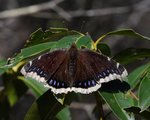
River talk
During a mid-month hike a week or so ago, there were a fair number of things to see and hear. Pileated woodpeckers calling and drumming, bald eagles and vultures soaring above the mountain tops, and lots of flying insects in the form of wasps and various small moths, including the aptly named Bluish Spring Moth.
There were some larger butterflies of what appeared to be the same species flying around as well. The coloration and size resembled that of a red-spotted purple, but it flew differently than a red-spotted purple would. When I got close enough to a perched individual and saw the light-yellow fringe on its wings, I recognized it as a mourning cloak (Nymphalis antiope). One of the nicknames for this species is “harbinger of spring.” Spring is the time that the mourning cloak can be seen in abundance.
Around March is when mourning cloaks are first spotted in numbers, about the same time as wood frogs start sounding. During the course of spring, adults find a mate, lay eggs and die soon after. The hatching caterpillars grow and eventually emerge from their chrysalis as adult butterflies in June or July.
After a brief period of foraging, they enter a period of estivation (or summer dormancy) before they go active again in early fall to feed and store energy for winter hibernation.
Mourning cloaks overwinter as adults in a crevice or other form of shelter. During this time, the mourning cloak manufactures natural antifreeze compounds, such as sorbitol and glycerol, to keep ice crystals from forming in its body.
In late winter, mourning cloaks can sometimes be seen taking brief flights on mild February days.
The mourning cloak is the first large butterfly to be seen in the spring in the region. The violet spots somewhat resemble the spots on a blue-spotted purple, and the black color of the wings is close to the shade of a black swallowtail, but the distinct light-yellow fringe on the morning cloak’s wings is a hallmark identifier for this species.
Related stories

Comments
No comments on this item Please log in to comment by clicking here